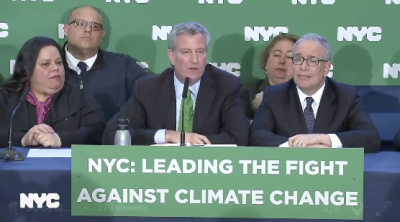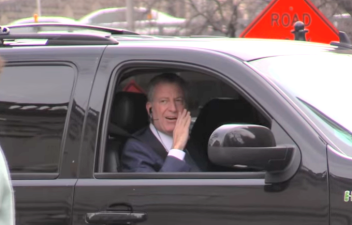It’s More Than “Cheap Symbolism” When the Mayor Rides Transit
De Blasio dismisses the importance of getting out of his SUV. But if the mayor doesn't regularly experience what it's like to get around without a car, he won't feel on a visceral level why improving transit, biking, and walking is so important.

On his weekly “Ask the Mayor” radio appearance this morning, Mayor de Blasio called on New Yorkers to take responsibility for climate change in light of Donald Trump’s decision to withdraw the United States from the Paris climate accords.
“We have to take disproportionate action, for our own good,” de Blasio said. “Let’s be leaders here, let’s show we can go even farther [than our goals].”
The mayor reiterated his administration’s commitment to reducing citywide greenhouse gas emissions 80 percent by 2050 and said, “the policies of this city are going to lead to addressing climate change in a much more aggressive way that it’s ever been addressed in the history of New York City.”
But when Charles Komanoff called in and asked whether de Blasio would “lead by example” and change his own travel habits, including his daily motorcade from the Upper East Side to the Park Slope Y, the mayor called it “cheap symbolism.”
“Whether I go to the gym does not affect the policies that affect millions of people,” de Blasio said.
This misses the major reason why a mayor should make an effort to experience the transit system. It’s not that his motorcade increases emissions, or even that it sends the wrong message. It’s that the way de Blasio gets around shapes how he views the city. And those views are inevitably going to influence his policies.
If he’s getting chauffeured in an SUV everywhere he goes, there’s no way the mayor can viscerally understand what the three-quarters of New Yorkers who don’t commute by car experience on a daily basis.
De Blasio insisted that his schedule requires him to be driven places, and that he “[uses] the subway when it makes sense to use the subway.” But documented instances of de Blasio riding the subway are few and far between. And he certainly doesn’t have first-hand experience riding overcrowded buses stuck on the city’s congested streets, nor does he bike in the city’s often-obstructed bike lanes.
From de Blasio’s perspective in the backseat, bus lanes aren’t doing anything to make his trips quicker. The mayor may know on an intellectual level that they are beneficial. But on a gut level, when you’re in a car, priority treatments for buses and bikes feel like they are getting in the way.
Through the levers of parking policy and the allocation of street space for transit, biking, and walking, de Blasio could substantially lower transportation emissions in NYC. More efficient streets are also essential for accommodating population growth, which delivers huge environmental benefits itself in a city like New York, where per capita emissions are so low.
But in discussing climate policy with Brian Lehrer, de Blasio focused almost exclusively on his administration’s push to retrofit buildings — the source of 68 percent of citywide emissions — for environmental efficiency. Besides a quick reference to the city’s efforts to electrify its own vehicle fleets, he made no mention of transportation, which accounts for more than quarter of the city’s emissions, mostly from motor vehicles.
“I do stay in touch with what people are going through,” the mayor insisted today, “and I knew it for years and years because for years and years I never even had any car.”
A first-hand refresher on the current state of the transit system is in order. A mayor who gets out and rides the bus — even just every now and then — would be less inclined to issue thousands of parking placards and more enthusiastic about carving out street space for transit.




